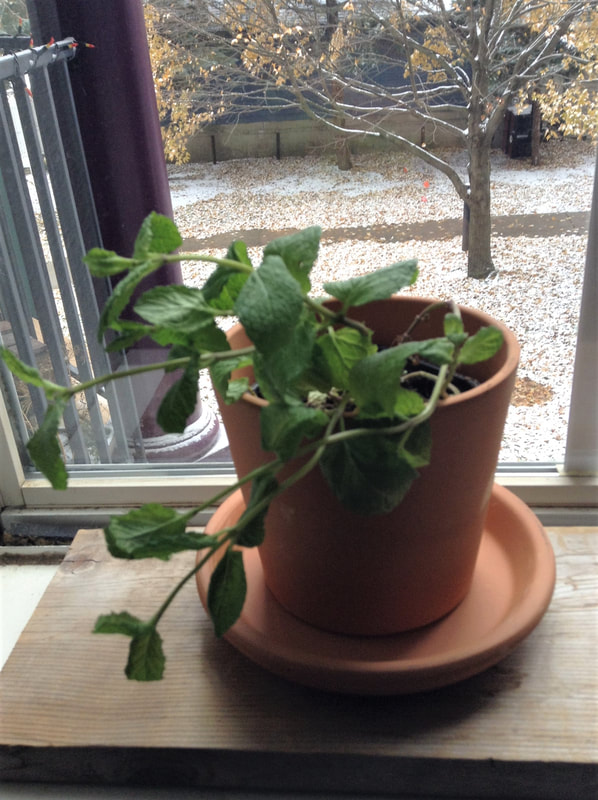|
Photo and story by Donna Iverson
The snow is falling. The temperature has dropped to 25 degrees. Most everything in the garden has frozen. It's only November, and already I am feeling the loss of growing green things. I even miss the weeds. Walking through the community garden this time of year seems like a forlorn exercise, until I spot the mint. It is green and still growing though partially buried in snow and even spreading both above and below ground, taking over an entire bed. I smile and rub some of the leaves between my fingers. It is one of my favorite herbs, partly because there is no stopping it. So be careful where you plant it. If you don't want it strangling out your other plants, buy an earthenware pot and plant the mint seedling inside. You can buy small mint plants at grocery stores these days, in the middle of winter. Then dig a hole in your garden, and drop the pot with the mint into it. Cover with soil leaving about two inches of the pot above ground. This prevents above-ground runners from spreading and becoming invasive. Come summer, your mint will grow to be about a foot high and bloom during the summer months, spreading its minty fragrance far and wide. As for me, I decided to bring the outdoors inside so snipped some mint cuttings and brought them home. There are two methods of growing mint from cuttings and I prefer the first. Which is to stick the cuttings into s small pot with moist soil. In a few weeks it will root and you can place your mint plant in a sunny window. The other method is to place the cuttings in a jar of water, and roots will form in a few weeks. The plant can then be transferred to a pot with soil, being careful not to damage the leaves while potting. Or, you can just buy a mint plant at your grocery store and skip the wait. The most popular mints are spearmint and peppermint but there are a lot of cousins out there including apple mint, chocolate mint, pineapple mint, water mint, horsemint, forest mint, and one of my favorites, wild mint. You can identify mints in the wild by their square stems and fragrance. It's natural habitats is along stream beds, which provide the moisture it needs to thrive. In addition to its culinary uses, mint is useful in the yard where it will deter mosquitoes, ants, fleas, flies and moths. It is even said to deter deer, although my sister-in-law swears nothing deters deer. If you are into companion planting, grow mint near tomatoes and cabbage where it attracts beneficial insects and deters harmful ones. In addition to adding it to a winter windowsill garden, I like to use it as an air freshener, by putting some sprigs in a vase in the bathroom. Mint also has medicinal qualities, and is said to smooth an upset stomach. But be careful if you have acid reflux, as it is contraindicated. It can also cause a rash in some people, such as contact dermatitis.
0 Comments
Your comment will be posted after it is approved.
Leave a Reply. |
Archives
April 2024
Categories |

 RSS Feed
RSS Feed